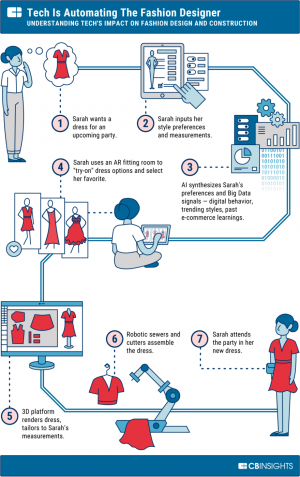Fast Fashion
Fast Fashion is an extremely popular business model that focuses on mass production, design, and marketing. The manufacturing relies on replicating trendy styles and low-quality materials in order to produce inexpensive clothing styles to the general public. These cheaply-made, trendy pieces have resulted in a large-scale movement within the fashion industry. [1]. The earliest version of fast fashion starts back in the 1960s with the paper clothing trend where one viral marketing campaign instigated the movement through paper napkins. [2]. Scott Paper Company originally tried to sell napkins and toilet paper in order to promote its new Dura-Weve material. Instead, two styles of shift dress emerged from this type of paper. In eight months, 500,000 units were sold, which prompted fast fashion business models during the late 20th century to manufacture cloth cheaper and easier, through new materials like polyester and nylon. This movement soon escalated to other new methods that fast fashion is known for, such as efficient supply chains, quick response manufacturing methods, inexpensive labor in sweatshop production, and low-labor bulk manufacturing industries in South, South East and East Asia. [3]. Companies like Uniqlo, H&M, and Zara built these business models based on inexpensive clothing from efficient production line to create more seasonal/trendy designs that are continuously marketed to fashion-conscious consumers. [4].
Contents
Technology in Fast Fashion Practices
Data Collection
Nowadays, fashion brands, including fast fashion and high-brand name ones are using modern technology to understand their customers better than ever before. Through online data collection, some companies are able to use artificial intelligence to reshape the company's approach to product design and development, which allows them to better predict what customers will want to look for and buy next. [6]. Big data analysis has already begun to take on a major role in forecasting customer behavior and buying patterns. The brands that have the resources and funds to obtain these analytics gives them a competitive edge over other smaller businesses. Because of these big data analytics, fast fashion brands can use it to revamp their marketing tactics in order to find and create the best, most profitable products to bring to their consumers. Now, in order to be successful within the fashion industry, brands need to predict fashion and industry trends to stay in touch with the ever-changing consumer preferences. [7]. The most useful services Big Data analytics can provide to companies through analyzing trends, identifying target markets, and improving cross-selling. Helping companies easily understand market trends by using data-driven sentiment analysis solutions on social media and other platforms ultimately aids them to market their products correctly.
Implementation of AI
AI is becoming the fore-front force in fast fashion practices. From design, manufacturing, logistic supply chain, and marketing, AI in the fashion industry is starting to transform how companies operate and maximize their profits. In the age of digitalization, AI and machine learning (ML) based technologies are providing automated solutions to provide the most efficient, cost saving methods. AI can act as a clothing designer because it can reduce forecasting errors by detecting new, in-demand trends. Because fashion trends vary on such a fast face, AI designers need to keep up with the new styles by analyzing designs through images to copying those popular styles. [8]. AI also plays a huge role in manufacturing and supply chains. AI is able to perform the labor-intensive tasks such as sewing, sorting, etc with a faster speed and accuracy, therefore reducing the extra cost of employees. Fast fashion companies are also able to mass produce their clothing because AI-enabled machines and robots can perfectly stitch the fabrics while being able to detect any faults in the fabric. AI in inventory and supply chain management speeds up the routes the products take by cutting the logistic supplies and shipping costs. Using these benefits, companies are able to have certain logistics and supply chain processes that offer faster delivery options and can also find alternate routes for vehicles if derailed by unforeseen circumstances. [9].
AI also provides virtual fitting rooms, where consumers are able to provide their personal data such as their height, weight and fit preferences, as well as 3D cameras. These algorithms then combine their information with its existing database of various items, styles, and sizes to recommend the best products from its brand partners to the consumer. This allows for personalized recommendations and easier access to products with contactless methods. [11].
References
- ↑ Linden, A. (2016). An Analysis of the Fast Fashion Industry. Retrieved 10 March 2021, from https://digitalcommons.bard.edu/cgi/viewcontent.cgi?article=1033&context=senproj_f2016
- ↑ Buck, S. (27 November 2017). This wild paper clothing trend of the 1960s was the early version of fast fashion. Retrieved 11 March 2021, from https://timeline.com/paper-fashion-1960s-43dd00590bce
- ↑ Joy, A. (2012). Fast Fashion, Sustainability, and the Ethical Appeal of Luxury Brands. Retrieved 12 March 2021, from https://www3.nd.edu/~jsherry/pdf/2012/FastFashionSustainability.pdf
- ↑ Gustashaw, M. (20 March 2017). Uniqlo Is Going to Start Producing Clothing at Zara Speeds. Retrieved 12 March 2021, from https://www.gq.com/story/uniqlo-fast-fashion-speed-zara-competition
- ↑ Stanton, A. (2019). What is Fast Fashion Anyway? Retrieved 12 March 2021, from https://www.thegoodtrade.com/features/what-is-fast-fashion
- ↑ CB Insights. (13 October 2020). The Future Of Fashion: From Design To Merchandising, How Tech Is Reshaping The Industry. Retrieved 12 March 2021, from https://www.cbinsights.com/research/fashion-tech-future-trends/#:~:text=And%20today%2C%20fashion%20technology%20is,up%20every%20aspect%20of%20fashion
- ↑ Business Wire. (12 June 2020). How Big Data Analytics Is Changing the Face of Fashion Retail. Retrieved 12 March 2021, from https://www.businesswire.com/news/home/20200612005108/en/How-Big-Data-Analytics-Is-Changing-the-Face-of-Fashion-Retail-Quantzig%E2%80%99s-Experts-Share-Valuable-Insights-in-Their-Recent-Article#:~:text=In%20the%20fashion%20industry%2C%20data,customer%20behavior%20and%20buying%20patterns.&text=Big%20data%20analytics%20is%20helping,to%20bring%20to%20the%20market
- ↑ Bisen, V. (18 January 2020). How AI is Changing Fashion: Impact on the Industry with Use Cases. Retrieved 12 March 2021, from https://medium.com/vsinghbisen/how-ai-is-changing-fashion-impact-on-the-industry-with-use-cases-76f20fc5d93f
- ↑ Schmelzer, R. (16 July 2019). The Fashion Industry is Getting More Intelligent with AI. Retrieved 12 March 2021, from https://www.forbes.com/sites/cognitiveworld/2019/07/16/the-fashion-industry-is-getting-more-intelligent-with-ai/?sh=15d0d973c74d
- ↑ CB Insights. (13 October 2020). The Future Of Fashion: From Design To Merchandising, How Tech Is Reshaping The Industry. Retrieved 12 March 2021, from https://www.cbinsights.com/research/fashion-tech-future-trends/#:~:text=And%20today%2C%20fashion%20technology%20is,up%20every%20aspect%20of%20fashion
- ↑ Shemar, K. (August 2020). Fashion & AI: the privacy of virtual fitting rooms. Retrieved 12 March 2021, from https://www.gerrishlegal.com/legal-blog/2020/9/8/fashion-amp-ai-the-privacy-of-virtual-fitting-rooms

